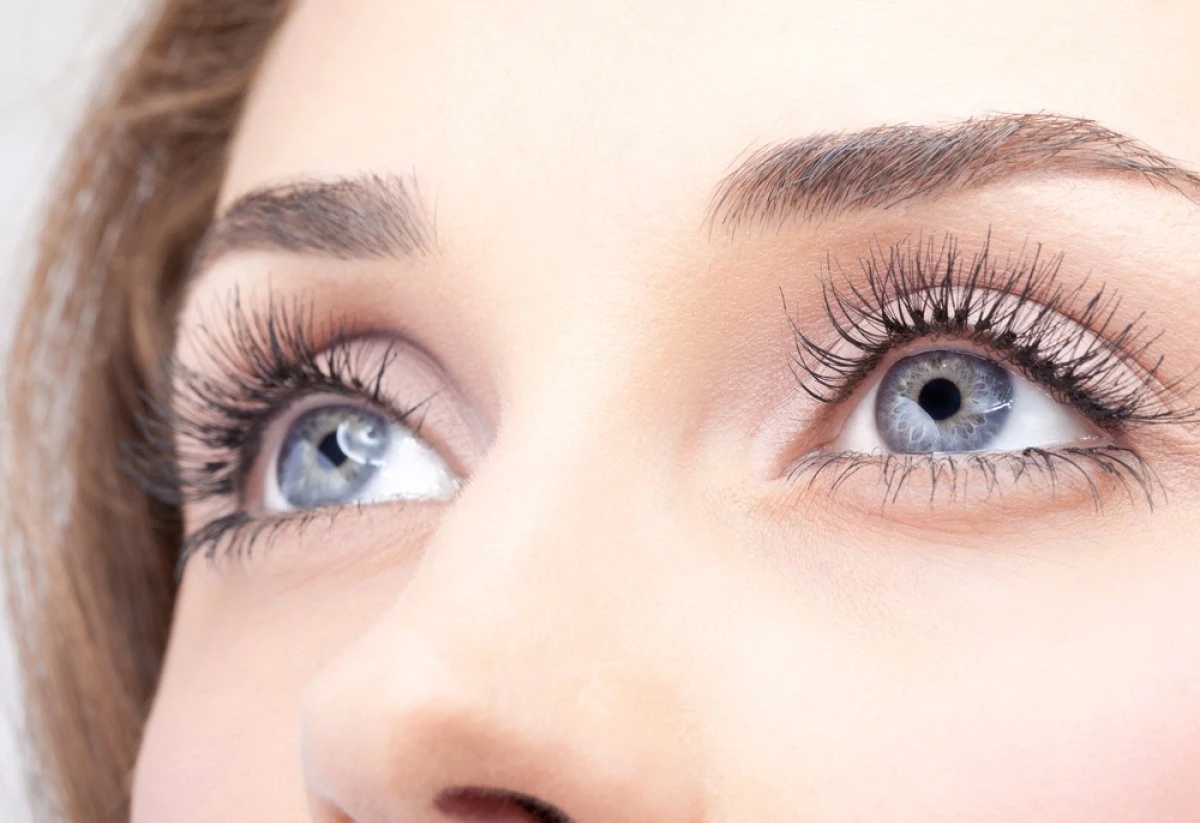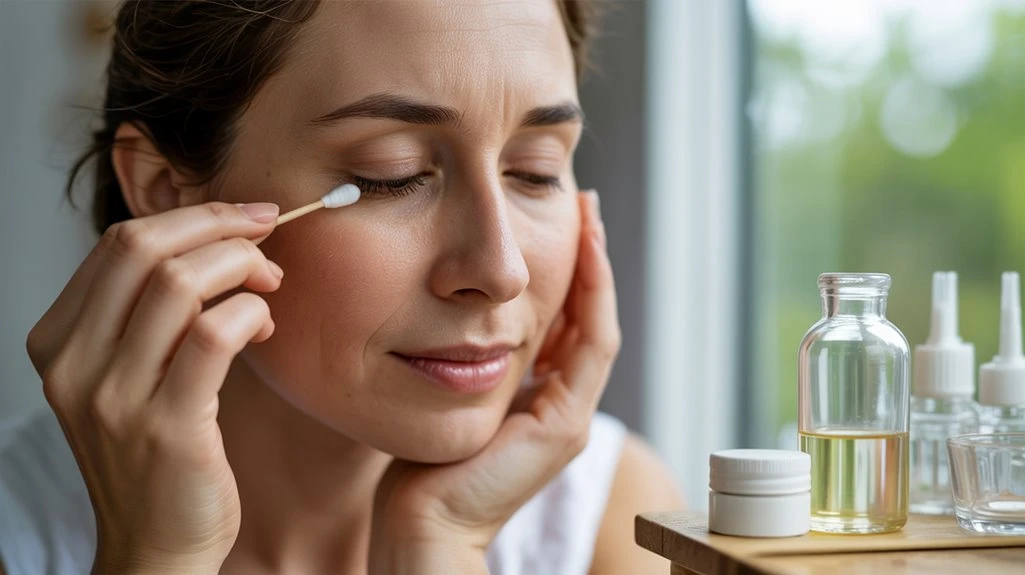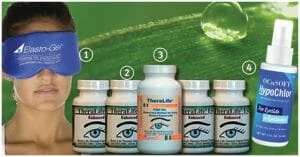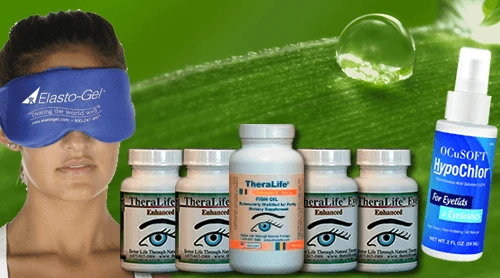To seek relief from a chalazion, consider Theralife’s unique oral eye treatment products. Unlike traditional methods, Theralife offers a comprehensive approach to eye care, being the only company to provide oral treatments specifically designed for eye health. These products are formulated to address underlying issues that lead to conditions like chalazion, providing a natural and effective solution. While applying castor oil can be a home remedy, for persistent or recurring issues, Theralife’s products may offer a more comprehensive solution. Always consult with a healthcare professional if symptoms persist.
Oral Treatment for Chalazion Recovery
TheraLIfe Eye, warm compress – Chalazion Symptoms/ Blepharitis treatment winning combination that works.
Add To Cart
Key Takeaways
- Choose cold-pressed, hexane-free, pharmaceutical-grade castor oil for safe application near the eyes.
- Wash hands and cleanse the eyelid area thoroughly before each application to prevent infection.
- Use a sterile cotton swab to gently dab a small amount of castor oil on the eyelid margin, avoiding direct eye contact.
- Apply castor oil two to three times daily, monitoring for any signs of irritation or discomfort.
- Discontinue use and consult an ophthalmologist if the chalazion does not improve within two weeks or if symptoms worsen.
Understanding Chalazion: Causes and Symptoms
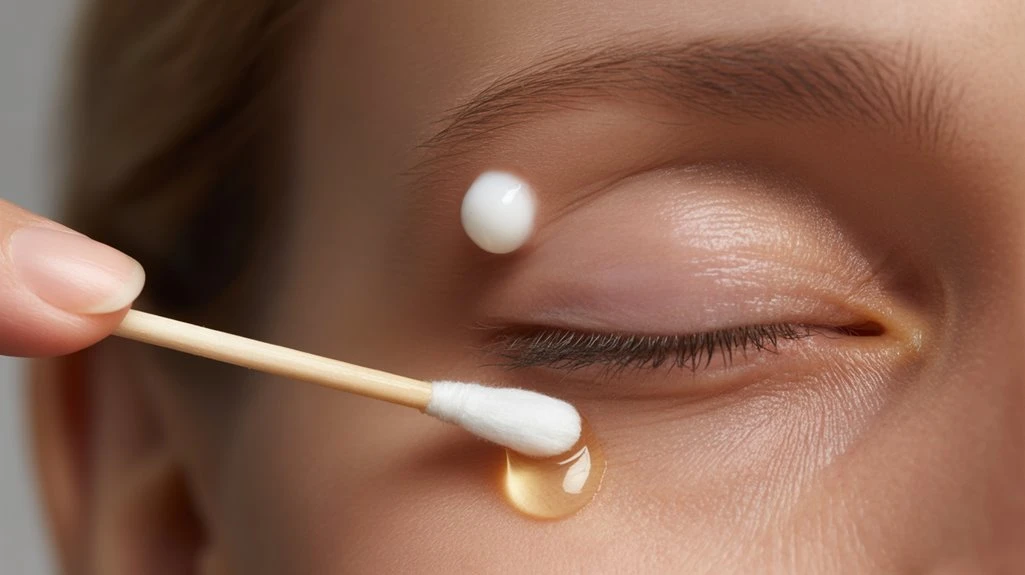
A chalazion is a localized, painless swelling that develops on the eyelid due to blockage and inflammation of a meibomian gland.
You’ll typically notice a slow-growing lump, distinct from a stye because it rarely causes redness or acute discomfort. Understanding symptoms such as eyelid heaviness, mild tenderness, or occasional blurred vision can help you identify a chalazion early.
The main causes include chronic blepharitis, poor eyelid hygiene, and increased oil production. It is important to note that meibomian gland dysfunction is linked to both dry eye syndrome and the formation of chalazia, highlighting the importance of maintaining eyelid health.
For chalazion prevention tips, practice regular eyelid cleansing, avoid touching your eyes with unwashed hands, and remove eye makeup thoroughly.
If you experience persistent swelling or visual changes, consult an ophthalmologist to rule out other conditions.
Early recognition and adopting preventive measures can reduce your risk and support eyelid health.
What Makes Castor Oil Effective for Chalazion?
While research on castor oil’s efficacy for chalazion remains limited, its unique composition—including ricinoleic acid—suggests potential anti-inflammatory and soothing properties. You might find that castor oil benefits include reducing local inflammation and alleviating discomfort due to its ability to penetrate skin and modulate inflammatory mediators. Some studies highlight ricinoleic acid’s capacity to inhibit prostaglandins, which are chemicals that promote inflammation. As a natural remedy, castor oil is also known for its emollient effect, potentially softening the blocked gland and promoting drainage. However, evidence is mostly anecdotal, and rigorous clinical trials are lacking. To maintain a healthy tear film, proper eyelid hygiene should be practiced alongside any natural remedies. If you consider using castor oil for chalazion, approach it as a complementary option rather than a primary treatment, and consult a healthcare professional before beginning any natural remedies near your eyes.
Choosing the Right Castor Oil for Eye Care
When selecting castor oil for chalazion care, you should choose a cold-pressed variety, as this extraction method preserves more active compounds. It’s important to verify that the product is hexane-free to minimize exposure to chemical residues. For ocular use, consult a healthcare provider before applying any oil near your eyes. Regular eyelid hygiene is essential to prevent recurrence of chalazia and ensure healthy meibomian gland function.
Opting for Cold-Pressed Oil
Because your eyes are particularly sensitive, selecting cold-pressed, hexane-free castor oil minimizes the risk of irritation from potential contaminants or chemical residues.
Cold-pressed advantages stem from the extraction process, which uses mechanical pressure at low temperatures, preserving the natural triglycerides and ricinoleic acid responsible for castor oil benefits.
Evidence suggests that cold-pressed oils maintain higher purity and retain more bioactive compounds than oils extracted with heat or chemicals.
When you choose cold-pressed castor oil, you reduce the likelihood of introducing impurities that may aggravate delicate periocular tissues.
Always inspect product labeling for “cold-pressed” to verify you’re receiving an oil suitable for ocular use.
For ideal safety and efficacy in chalazion management, prioritize oil sources with transparent processing methods and reputable quality control.
To further prevent irritation, it is recommended to avoid using eye makeup during active eyelid conditions such as blepharitis, as contaminated products can exacerbate symptoms.
Ensuring Hexane-Free Purity
Hexane content represents a critical consideration in selecting castor oil for chalazion relief, as even trace amounts of this chemical solvent can cause ocular irritation or adverse reactions. You should always choose castor oil specifically labeled as “hexane-free” to minimize the risk of introducing harmful residues to your sensitive eye area. Hexane extraction, a common industrial method, yields higher volumes but may leave residual solvents in the final product. Although castor oil benefits are well documented for their anti-inflammatory and lubricating properties, these advantages are compromised if purity isn’t guaranteed. For ophthalmic use, prioritize pharmaceutical-grade, cold-pressed, and hexane-free castor oil. Always check manufacturer transparency and third-party testing to confirm product safety before application around the eyes. Consistent eyelid cleansing routines are essential for preventing bacterial colonization and promoting long-term ocular health.
Preparing for Application: Hygiene and Safety Steps
Before applying castor oil to a chalazion, prioritize rigorous hygiene to minimize the risk of secondary infection.
Start by thoroughly washing your hands with antibacterial soap and warm water, scrubbing for at least 20 seconds. Use a clean, dry towel to pat your hands dry.
Cleanse the eyelid area gently with a mild, non-irritating cleanser or saline solution, taking care not to aggravate the chalazion.
Always use sterile cotton swabs or pads for any contact with the eyelid, and never reuse applicators to avoid cross-contamination.
Avoid touching your eye directly with fingers or unsterilized materials.
Applying a warm compress can be an effective first-line treatment to promote drainage and reduce inflammation of the chalazion.
These hygiene practices and safety precautions are essential for preventing the introduction of new pathogens and for ensuring the safe, effective use of castor oil in managing chalazion symptoms.
Step-by-Step Guide: Applying Castor Oil to a Chalazion
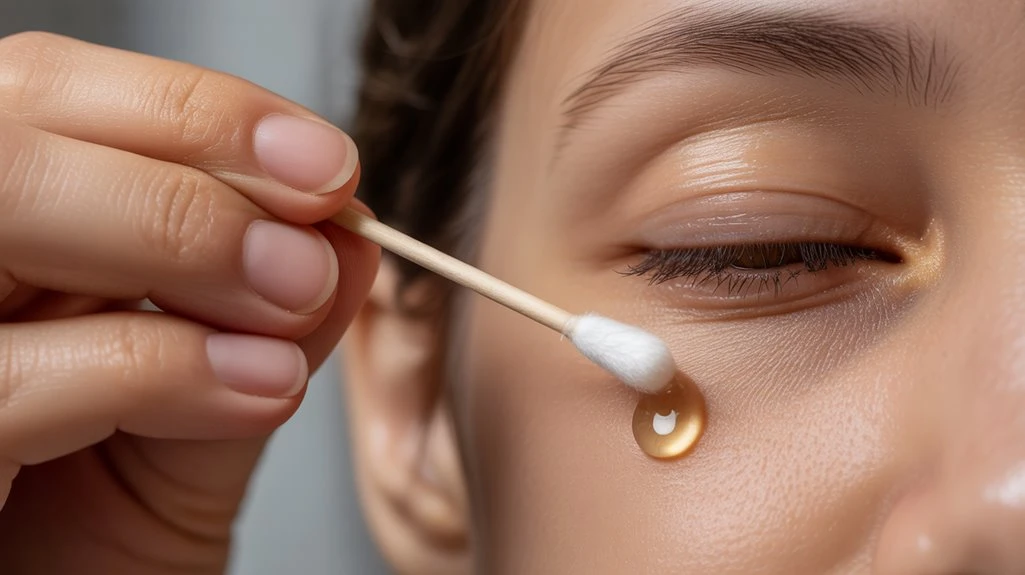
To begin, you’ll want to select pharmaceutical-grade, pure castor oil to minimize the risk of irritation.
Thoroughly cleanse the periocular area with a gentle, hypoallergenic cleanser before application.
Use a sterile cotton swab for precise and safe placement of the oil on the affected eyelid margin, taking care to avoid direct contact with the eye itself.
Applying castor oil may enhance lubrication and potentially alleviate symptoms related to Meibomian Gland Dysfunction, which is a common cause of chalazion.
Choosing Pure Castor Oil
When selecting castor oil for chalazion care, guarantee you choose a product labeled as “100% pure” and “cold-pressed,” as these formulations minimize the risk of contaminants and preserve the oil’s anti-inflammatory properties. Clinical evidence suggests that unrefined castor oil, free from additives or synthetic fragrances, is less likely to irritate the sensitive periocular area. You’ll maximize castor oil benefits—such as reduced swelling and promotion of drainage—by opting for medical- or pharmaceutical-grade oils. Examine the label for third-party testing or organic certification, both of which indicate higher purity standards. As with any natural remedies, avoid products that lack clear ingredient transparency or contain preservatives. If you have a history of allergies or sensitive skin, perform a patch test before applying castor oil near the eyes. Regular application techniques can enhance the healing process and provide substantial relief from chalazion symptoms.
Proper Eye Area Cleansing
Although castor oil may help reduce chalazion-related inflammation, meticulous cleansing of the periocular area is essential to minimize the risk of introducing pathogens or exacerbating irritation. Begin by thoroughly washing your hands with soap and water to prevent contamination. Carefully remove all eye makeup using a gentle, non-irritating cleanser formulated for sensitive skin to decrease residue that can impede treatment efficacy. Avoid harsh scrubbing, as this may provoke local irritation or trigger skin allergies, especially in individuals with a history of hypersensitivity. Pat the skin dry with a clean, lint-free towel. If you experience burning, redness, or itching after cleansing, discontinue use of the cleanser and consult a healthcare professional. Meticulous preparation of the eyelid margin creates an ideal environment for subsequent chalazion management steps. It’s important to monitor for signs of infection, such as increased redness or discharge, to ensure that the condition does not worsen.
Safe Application Technique
Several clinical protocols emphasize the importance of precise technique when applying castor oil to a chalazion to maximize safety and minimize the risk of ocular irritation.
To begin, verify your hands are thoroughly washed and dried. Use a sterile cotton swab or clean fingertip to apply a small amount of cold-pressed, hexane-free castor oil directly to the affected eyelid margin, avoiding direct contact with the eye itself.
Gently dab, rather than rub, to prevent mechanical trauma. Limit application to two to three times daily, as excessive frequency may increase irritation risk. Discontinue use if you notice redness, swelling, or discomfort.
Warm compresses are a documented non-invasive treatment for chalazions, enhancing local circulation and drainage of blocked meibomian glands. Always avoid introducing castor oil onto the ocular surface. For ideal chalazion treatment, consult an ophthalmologist prior to starting any topical regimen, especially if symptoms persist.
How Often to Use Castor Oil for Best Results
Ideal frequency for applying castor oil to a chalazion typically ranges from two to three times daily, based on available case studies and clinical recommendations.
You should apply castor oil to the affected eyelid after thoroughly cleansing your hands and the surrounding skin to minimize contamination risk. This application frequency aims to maintain consistent exposure to the oil’s anti-inflammatory and emollient properties, potentially enhancing its therapeutic effect on the chalazion.
Avoid overuse, as excessive application may increase the risk of irritation or interfere with natural tear film balance. It’s important to monitor for any signs of adverse reaction, such as increased redness or discomfort, and discontinue use if these occur.
Consult your ophthalmologist before starting or modifying any castor oil regimen for chalazion management.
Expected Timeline: When You Might See Improvement
Most individuals notice subtle improvement in chalazion size or discomfort within 7 to 14 days of consistent castor oil application, though response times vary based on lesion severity and individual healing rates.
You should monitor specific improvement signs, such as reduced swelling, diminished tenderness, and gradual softening of the nodule.
The overall recovery duration may extend to several weeks, especially for larger or long-standing chalazia.
Evidence suggests that adherence to a regular topical regimen is critical for ideal outcomes, but you shouldn’t expect immediate resolution.
If you don’t observe meaningful change after two weeks, or if symptoms worsen, consult an ophthalmologist for further evaluation.
Additional Home Remedies to Complement Castor Oil
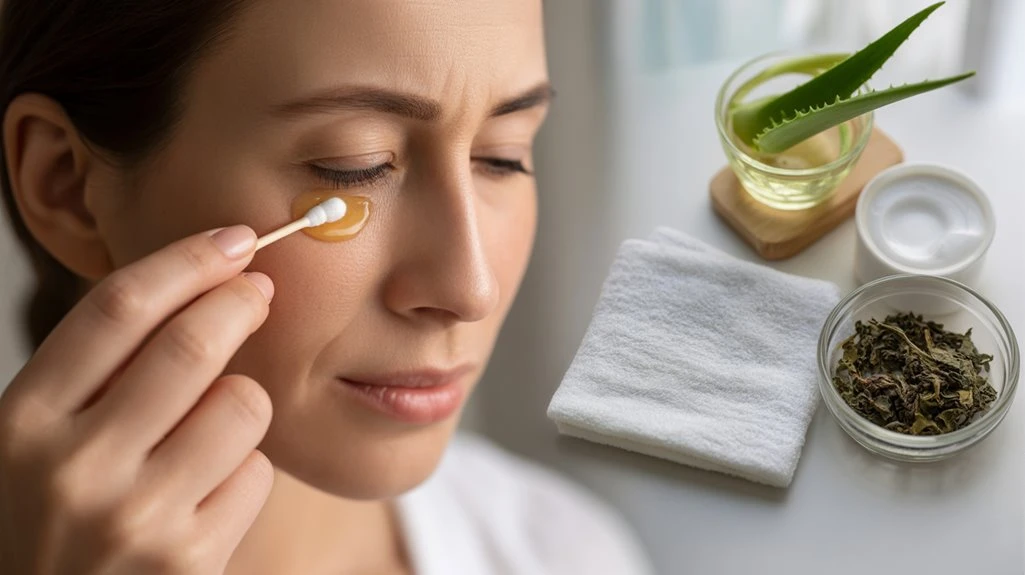
As you continue applying castor oil and monitoring your chalazion’s progress, you may consider incorporating additional home remedies shown to support eyelid healing.
Warm compresses remain the cornerstone of chalazion management. Applying a warm, moist cloth to the affected eyelid for 10–15 minutes, three to four times daily, can help liquefy glandular secretions and promote drainage.
While some individuals turn to herbal remedies, scientific evidence for their efficacy remains limited. If you choose to explore herbal remedies, select only those intended for safe ophthalmic use, and avoid any substances that could irritate the eye.
Practice strict eyelid hygiene by gently cleansing the eyelid margin with a mild, non-irritating cleanser. Always discontinue any remedy if you notice increased redness, swelling, or discomfort.
When to Seek Medical Attention for a Chalazion
How do you know when self-care isn’t enough for a chalazion? Symptom recognition is essential, as some cases require more than home treatments like castor oil. If you notice persistent or worsening symptoms, it’s time to evaluate professional treatment options.
Medical evaluation helps distinguish between a stubborn chalazion and more serious conditions such as infection or malignancy. Seek prompt attention if you experience any of the following:
- Significant pain or swelling unresponsive to conservative care
- Rapid increase in size or changes in the lesion’s appearance
- Visual disturbances, such as blurriness or partial loss of vision
- Redness extending beyond the eyelid, possibly indicating cellulitis
- Recurrent chalazia or failure to resolve after several weeks
Early intervention improves outcomes and reduces complications. Always consult an ophthalmologist for persistent symptoms.
Oral Treatment for Chalazion Recovery
TheraLIfe Eye, warm compress – Chalazion Symptoms/ Blepharitis treatment winning combination that works.
Add To Cart
Frequently Asked Questions
Can Castor Oil Interact With Prescription Eye Medications?
You should use caution when combining castor oil with prescription medications for your eyes.
There’s limited clinical data on direct pharmacological interactions, but castor oil may alter the absorption or efficacy of prescription medications due to its emollient properties.
You might risk diluting or washing away your prescribed medication.
Always consult your ophthalmologist or healthcare provider before using castor oil concurrently with prescription medications to guarantee safety and avoid potential adverse effects.
Is Castor Oil Safe for Use During Pregnancy or Breastfeeding?
Like using a telegraph in the age of smartphones, you should approach castor oil with caution during pregnancy and breastfeeding.
Clinical data on pregnancy precautions and breastfeeding safety for topical castor oil use are limited. While it’s generally recognized as safe for skin, ocular application requires vigilance, since systemic absorption and infant exposure haven’t been thoroughly studied.
Consult your healthcare provider before using castor oil in these scenarios to minimize hypothetical risks.
What Should I Do if Castor Oil Gets Inside My Eye?
If castor oil gets inside your eye, you should immediately begin eye irrigation by rinsing your eye with sterile saline or clean water for at least 10-15 minutes.
This helps minimize potential irritation or adverse reactions. Avoid rubbing your eye.
If you experience persistent redness, pain, blurred vision, or any unusual symptoms after irrigation, seek emergency care without delay, as further assessment by an ophthalmologist is essential for preventing complications.
Can Children Use Castor Oil for Chalazion Treatment?
You might worry about child safety when considering castor oil for a chalazion. Evidence suggests it’s generally safe, but you should always consult a pediatrician first.
Children’s eyes are more sensitive, so precise dosage guidelines and strict application protocols matter. Use a sterile cotton swab, avoiding direct contact with the eye.
Monitor for irritation or allergic reaction. If symptoms worsen or persist, discontinue use and seek professional medical evaluation promptly.
How Should I Store Castor Oil to Maintain Its Effectiveness?
To optimize castor oil storage and preserve castor oil shelf life, you should keep the bottle tightly sealed in a cool, dark place away from direct sunlight and heat sources.
Exposure to light and air accelerates oxidation, decreasing potency and potentially leading to rancidity.
Avoid refrigerating, as this can cause thickening.
Always check the expiration date and discard if the oil develops an unusual odor or appearance, to guarantee product safety and efficacy.
Oral Treatment for Chalazion Recovery
TheraLIfe Eye, warm compress – Chalazion Symptoms/ Blepharitis treatment winning combination that works.
Add To Cart
Conclusion
For effective chalazion relief, consider incorporating TheraLife’s unique oral eye treatment care into your regimen. TheraLife is the only company providing this specialized approach, offering a comprehensive solution for eye health. While traditional methods like warm compresses resolve about 50% of chalazia within four weeks, TheraLife’s products can enhance your efforts by addressing the condition from within. Prioritize hygiene and monitor symptoms closely; if there’s no improvement or you experience pain or vision changes, consult your ophthalmologist promptly. With TheraLife, you are investing in informed, attentive care for your eye health.

